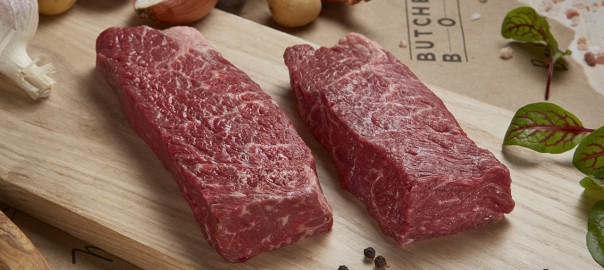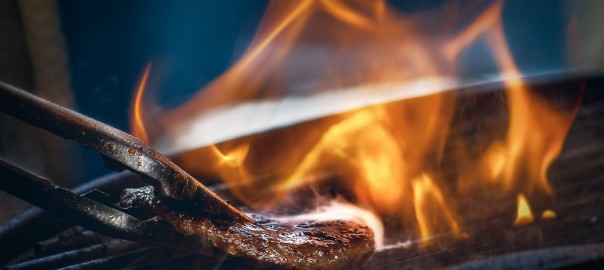Last fall, ButcherBox hosted a large, family-style meal at a small farm outside of Boston. In attendance were some of our most loyal members. For the event, ButcherBox Head Chef Yankel Polak cooked up an array of different ButcherBox cuts of beef, chicken, and pork.
The dinner at Matlock Farm required more than 150 ingredients to cook dishes like grass-fed New York strip steak and free-range organic boneless chicken thighs for about 30 people. In a blog post from last fall, Chef Yankel explains all the intricate planning and work that went into pulling off an amazing evening in a relatively remote locale.
Last week, Chef Yankel repeated the feat, cooking a massive meal for the entire ButcherBox team as the company officially opened its new test kitchen and content studio in an old warehouse on the North Shore of Massachusetts.
This time, however, he took less of the catering approach and used some strategies, planning, and skills that anyone can mimic if they are trying to cook for a large crowd this summer.
Here are the key takeaways from Chef Yankel’s guide to cooking for a crowd:
Plan ahead – Food and tools
Chef Yankel has a ton of experience on what does and what doesn’t work when cooking for a large number of people. The lessons learned have led to an important insight: Detailed planning is integral to pulling off a large meal.
The first key is making sure you have enough food. With cooking for a large group, it is better to have leftovers than to leave people wanting more. With side dishes, it is a little easier to gauge how many dishes to make based on the crowd you have coming. It is much easier to make an extra tray of vegetables or potatoes and let people take the excess home.
When it comes to meat, especially burgers, it is a little trickier.
Most people will eat a fist-sized piece of steak — between 4 to six ounces — or one small grilled chicken breast at a cookout. You can get filet mignon that size or get a larger steak, like ribeye steak, that is shared among a couple of guests. With flank steaks, skirt steaks, and similar slicing steaks, consider cuts that can be split between three to four eaters. That way, if you have 12 guests, you can get four skirt steaks to grill up.
With burgers, the ideal size is between a quarter of a pound and a bit more than a third of a pound, depending on your guests’ appetites. If you are making smaller burgers, you can get four out of one pound of ground grass-fed beef. If you are making some heftier cheeseburgers, you can get four six-ounce burgers out of one-and-a-half pounds of ground beef.
Beyond the food, make sure you have all the tools and backups you need. If using a gas grill, make sure to have a spare propane tank on hand; with charcoal, make sure you fire up enough when starting the grill, so you don’t lose heat. It’s easy to forget key tools like spatulas, tongs, knives, and cutting boards, but they are likely not far from where you are cooking your food. If you don’t have dishes or tins to store the food you cook and some tin foil to keep it warm until all the other food is ready to eat, you are going to have some cold food and unhappy guests.
Also, never forget your meat thermometer. Undercooked or over-cooked food is the cardinal sin of hosting a large, grilled meal.
Keep it simple – Salt, pepper, oil, and then add a few fresh ingredients
When you have a delicious grass-fed steak, like a New York strip steak, all you need to do to make it taste amazing is coat it with some kosher salt and fresh ground pepper. When it comes to marinades, rubs, or seasoning for sides, the fewer, the fresher, the better.
Olive oil is one of the keys to almost everything you’ll cook. It can be used as a base for marinades. Olive oil is good to toss veggies in after they’ve cooked — balsamic vinaigrette is also perfect to add to grilled vegetables like asparagus, summer squash, peppers, and onion…after they cook.
However, olive oil is essential for cooking almost everything on the grill for one reason. Instead of putting too much olive oil in a marinade or directly on the vegetables you might be grilling, use it to coat the grill. Grab a clean rag, dip it in the olive oil, and then rub it over the grates lightly. This is one of Chef Yankel’s top grilling tricks, and it keeps food burning and drying flare-ups to a minimum.
Time it out
You are going to need to remember a few things about timing.
Cook your sides first. They don’t lose any flavor or freshness if kept warm and then quickly reheated before serving. In the video below, Chef Yankel uses two grills but makes sure to cook the item that takes longest for his meal — the potatoes — first. That way, you can cook the meat closer to serving time.
We’ve shared the importance of letting your meat rest many times. But it’s still important to reiterate: Let chicken, pork, and steak rest sit at room temperature for eight to ten minutes before cutting or serving. This allows the natural juices to disperse.
Cooking large amounts of meat
When cooking steak, chicken, or pork, Chef Yankel uses two methods that get equal results. Both require setting up two different temperature zones on the grill. With a gas grill, that can be done by raising or lowering the heat of the burners. On a charcoal grill, once you’ve fired up your charcoal, move it to one side of the grill.
The more common practice — and one that is easier when cooking larger quantities of meat — is to put the steak, pork, or chicken on the hot side first and to turn for a few minutes each side. This creates a char or sear that generates a ton of flavor and texture, which is why we sear. in once you move it to the lower temperature side to finish cooking. The other method — one Chef Yankel uses for New York strip steaks and filet mignon, more tender cuts — is the reverse sear. Basically, it is the opposite of the first grilling technique. Cook on the warm side first and then finish by searing on the hot section of the grill.
While you could cook a few filets or ribeye steaks at once, it makes more sense to use a cut of beef like flank steak or skirt steak for larger groups. You can put three to four decent size skirt steaks — marinated with any number of delicious, savory flavors — on the grill at the same time and they cook evenly.
For burgers, you can cook on even heat. No need to sear. But make sure to give burgers the same post-grilling rest period as other meats.
A vital step in this process, especially when cooking a bunch of steaks, is to get the correct level of doneness. To do that, you need a meat cooking chart and a meat thermometer — we love the Thermapen instant-read thermometer — to get the perfect internal temperature.
With a steak, get the temperature five to 10 degrees cooler than the temperature you are trying to achieve as it will continue to cook when resting.
As always, make sure to cut your steak against the grain. If you watched the video above, you’ll notice Chef Yankel likes to cut a flank steak in half, with the grain, before cutting against the grain in smaller pieces.
More than anything, have fun! There’s no point in hosting a cookout or grilling for a party if you are going to stress while prepping and cooking the meal. Get others involved and crank some cooking music and enjoy!






